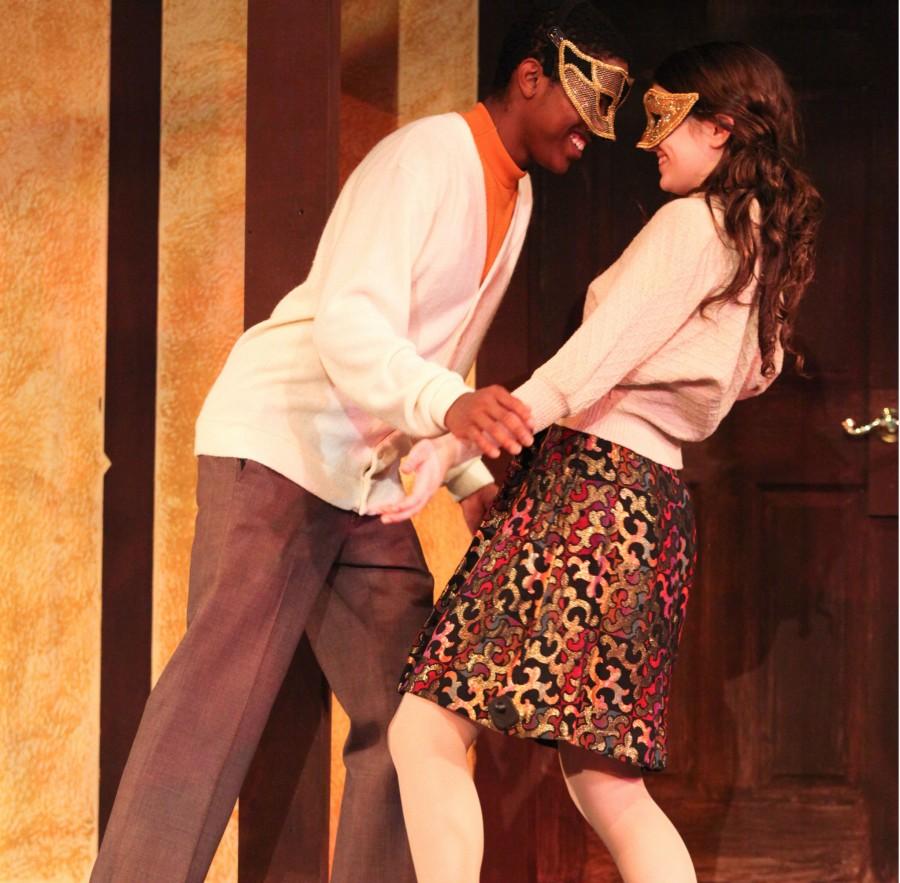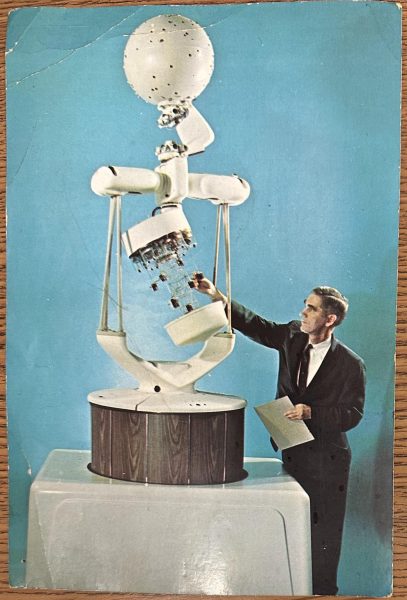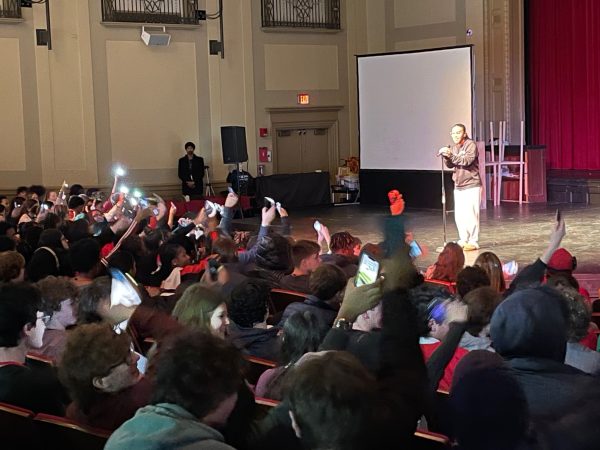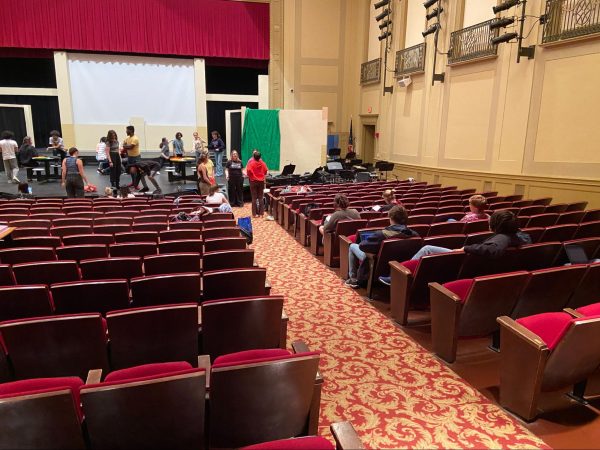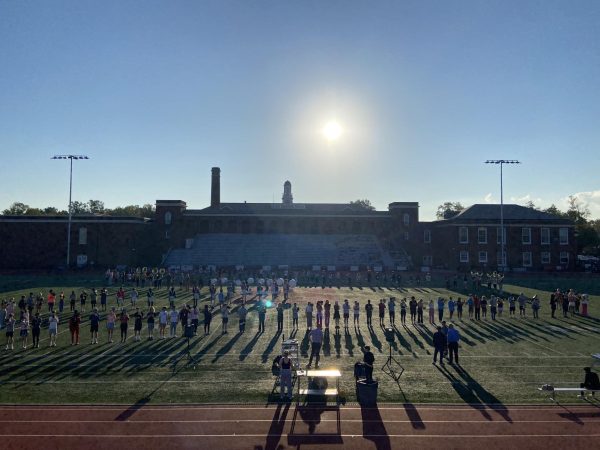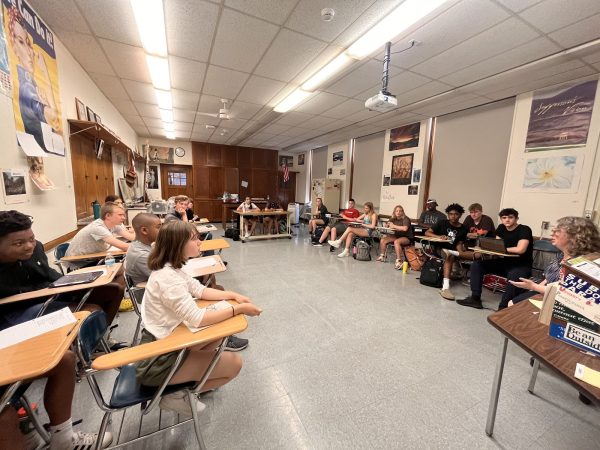Modernizing an Old Classic Takes Time
Shaker’s attempts to bring Romeo and Juliet into the modern day create an unorganized show
Romeo (Tony Jones) and Juliet (Emily Kenville) first meet at the Capulet’s party.
The Shaker Theatre Department’s rendition of Shakespeare’s “The Tragedy of Romeo and Juliet” is a conglomerate of old and new, due to the theatre department’s choice to place it in the 1950’s, creating a somewhat disorganized product. While the acting was professional, the staging engaging and the inclusion of different genders and races successful, “Romeo and Juliet” just failed to excite.
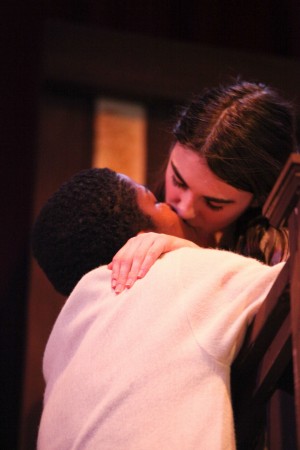
Romeo and Juliet kiss in the famous balcony scene.
Shakespeare’s works, with their complex language and clashing themes, are difficult for any high school ensemble to pull off. That said, our theatre department is not the usual program. With seven classes offered and multiple selective shows each year, Shaker’s theatre department is known for its artistic vision. In past years, this vision and unique take on theatre has left audience members surprised and intrigued.
“Romeo and Juliet”’s actors tell the story in a fresher, more modern way. Junior Emily Kenville plays the role of Juliet as a childish girl. Her voice is high and slightly shrill, and her blocking and choreography are usual for someone young and impatient. The audience member can see her character evolve as she meets Romeo, played by junior Tony Jones. He explores the role differently, showing a fascination for everything around him. The production successfully included varying genders and races, leading to intense moments on stage and highlighting director Christine McBurney’s main goal — to draw out the most famous and very provocative scenes.
In the famous balcony scene, where Juliet exclaims “Romeo, Romeo, where art thou?” Kenville and Jones are magnificent, with extreme drama and perfectly executed blocking.
Junior Gus Mahoney plays the Nurse, a female character, in a wig and dress. In contrast to his intense portrayal of Javert in “Les Miserables” last year, Mahoney’s performance as Nurse is hilarious and eloquent. Mahoney seems to show the comedic character that Shakespeare intended in a way that is more similar to modern-day society.
Junior Lillie Baum (Benvolio), junior Sydney Keller (Mercutio) and sophomore Samira Colbert (Tybalt) play their parts with ease and showmanship. Colbert’s commanding voice and Keller’s dramatic actions create eye-catching conversations and battles. While all three are female students playing the role of originally male characters, the costumes and roles make it work. These casting decisions follow the Shaker theatre department’s tradition of bringing the characters into a more modern and diverse light.
The blocking and choreography are masterful. Fight director Scott Sumerak captures the audience’s attention with realistic fight scenes. The dance in Act I where Romeo meets Juliet is especially surprising, transitioning from an old, slow dance to a fast-paced sock hop dance that more accurately represents a newer time period.
McBurney’s decision to set the play in the 1950’s both succeeds and fails. Characters like the Nurse and Lord Capulet are integrated into this time period with appropriate actions, personalities and costumes.
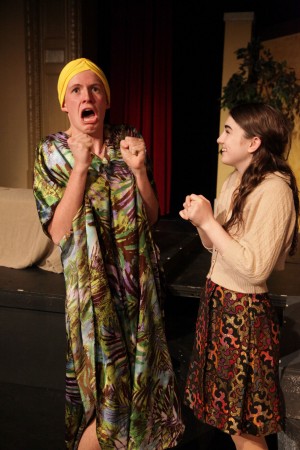
The Nurse (Gus Mahoney) gossips with Juliet.
Unfortunately, Benvolio and Mercutio are stuck in the 1590’s. Their costumes would be considered unusual for the 1950’s, with frills, crazy colors and a jester-like effect. McBurney attempts to draw on the 50’s with music and choreography, but the overall tone is that of the 1590’s version. The play takes some inspiration from Baz Luhrmann’s “Romeo + Juliet”, mixing old with new.
That’s where “Romeo and Juliet” has its biggest flaw. The language and transition music seem to be in a constant fight, forcing the audience to choose between finding the new elements or pretending that Shaker changed nothing and the show is exactly the same. It is uncomfortable, and the change in time period seems to be more of a last minute addition. If the show followed its traditional roots, maybe it would have succeeded. The show has trouble living up to the Shaker name.
In previous shows, like last year’s Spring Ensemble Show “Rough Magic” and the Fall Show “Les Miserables,” the set was more memorable. In “Rough Magic,” the set included huge puppet mirroring the character Prospero. “Romeo and Juliet” centers completely around a set that contains only a house, balcony and brick-like bed. Nothing about the set is wrong, but nothing is especially right.
The costumes are different. While some costumes like Mahoney’s and sophomore Jojo Attias’ reflect the time period and are provocative, others seem too old or too new. Mercutio’s costume has frills and would be odd to find in the 1950’s or now. While the actors succeeded in bringing Romeo and Juliet’s story to the modern day, Shaker’s theatre department didn’t do enough to bring it all together.
The lighting in past Shaker shows have been outstanding, and a lot of work is put into illuminating the actors and the set. Sadly, for “Romeo and Juliet,” the lighting department missed out on opportunities to put some artistic choice into the lighting. The lighting seems to be an afterthought, simply illuminating the stage, and fails to grab attention, as it did in last year’s Freshman Show “Masks.”
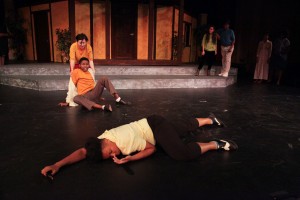
Romeo and Benvolio look on at the dead Tybalt (Samira Colbert).
It is almost impossible to compare “Romeo and Juliet” to the awe-inspiring “Les Miserables.” In addition, musicals, with their dancing and singing, are more of a spectacle and are far more popular with students. So it makes sense that this year’s fall production would be less popular than last year’s.
The production was successful in including different genders and races, creating intense moments on stage and bringing some aspects of Shakespeare’s classic to life. While the actors succeeded in bringing “Romeo and Juliet”’s story somewhat to the modern day, the overall switch to the 1950’s was lost on the audience.

